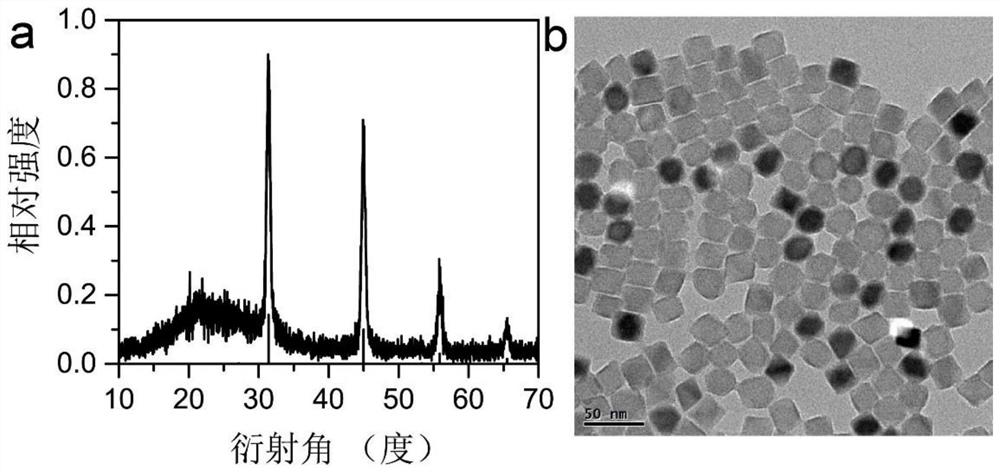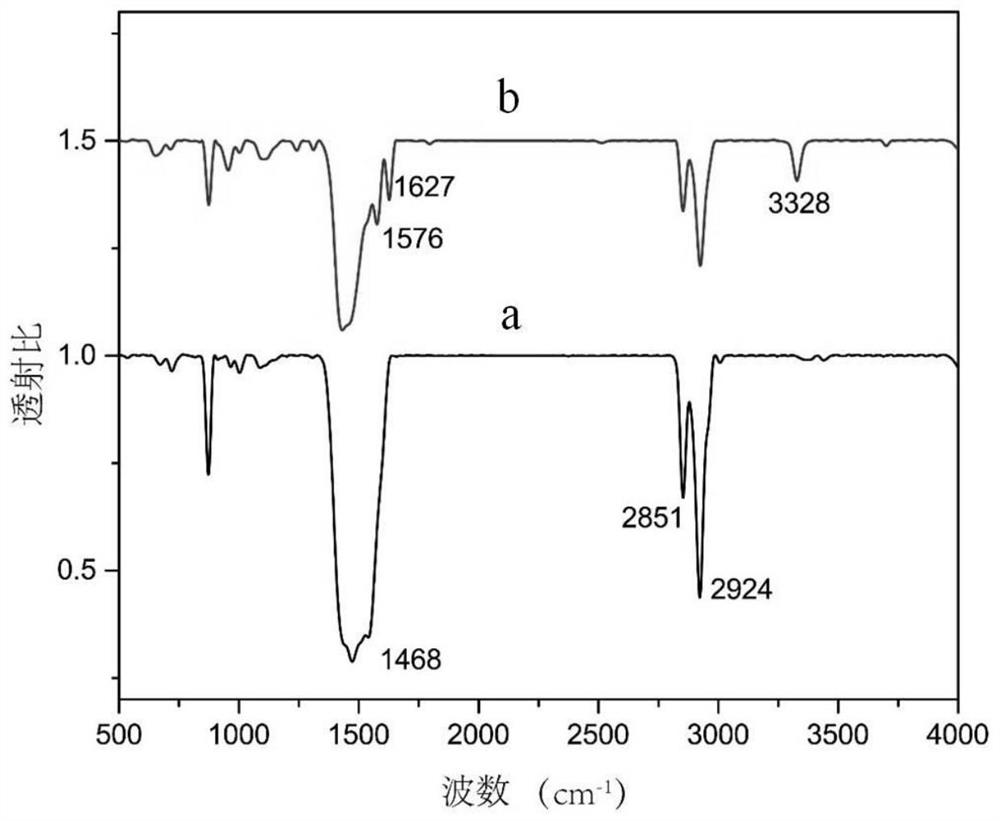Method for detecting hydrogen peroxide and related targets based on CaS nano fluorescent probe
A nanoprobe and detection method technology, applied in the field of detecting hydrogen peroxide and related targets based on CaS nanofluorescent probes, can solve demanding problems
- Summary
- Abstract
- Description
- Claims
- Application Information
AI Technical Summary
Problems solved by technology
Method used
Image
Examples
preparation example 1
[0086] Preparation example 1 oil-soluble CaS:0.07mol%Ce 3+ ,0.5mol%Er 3+ Preparation of nanoparticles
[0087] 1) Weigh 0.9943mmol Ca(CH 3 COO) 2 ·H 2 O, 0.0007mmol Ce(CH 3 COO) 3 4H 2 O, 0.005 mmol Er(CH 3 COO) 3 4H 2 O Then add 2mL oleic acid, 6mL oleylamine and 12mL trioctylamine, heat to 120°C with nitrogen gas and keep it warm for 30 minutes to form a transparent solution A;
[0088] 2) Then cool down to room temperature; weigh 3mmol of DPTU (N,N'-diphenylthiourea), dissolve it in 10mL of ethanol, and add it dropwise to solution A, continue to stir for 10min to fully mix, and heat up Heat at 80°C for 30 minutes to form a transparent solution B;
[0089] 3) Raise the temperature to 320°C, keep it warm for 1 hour, and then lower it to room temperature; add 20mL of ethanol to precipitate, separate and wash several times to obtain oil-soluble CaS of about 26nm: 0.07mol%Ce 3+ ,0.5mol%Er 3+ nanoparticles.
[0090] figure 2 In a is oil-soluble CaS:0.07mol%Ce 3+ ...
preparation example 2
[0091] Preparation example 2 water-soluble CaS:0.07mol%Ce 3+ ,0.5mol%Er 3+ Preparation of nanoparticles
[0092] 1) the oil-soluble CaS obtained in Preparation Example 1:0.07mol%Ce 3+ ,0.5mol%Er 3+ Nanoparticles were dissolved in chloroform to obtain solution one, CaS in solution one: 0.07mol% Ce 3+ ,0.5mol%Er 3+ The concentration of nanoparticles is 2 mg / mL;
[0093] 2) DSPE-PEG-NH dissolved in chloroform 2 Add it dropwise into solution 1 under constant stirring to obtain solution 2;
[0094] Step (1) oil-soluble CaS:0.07mol%Ce 3+ ,0.5mol%Er 3+ Nanoparticles with DSPE-PEG-NH 2 The mass ratio is 1:5;
[0095] 3) React solution 2 at 30°C for about 5 hours, and wait for the chloroform to evaporate completely;
[0096] 4) Centrifuge after step 3) and wash with deionized water several times to obtain DSPE-PEG-NH 2 The modified water-soluble rare earth-doped CaS nanomaterials are redispersed in ultrapure water and stored at 4°C for use;
[0097] image 3 For CaS:0.07m...
Embodiment 1
[0100] The present embodiment is used for the biological detection of hydrogen peroxide, and the following are specific operation steps:
[0101] (1) Use a polystyrene 96-well plate as the carrier used for detection, and add 8 rows of 100 μL of CaS:0.07mol% Ce obtained in Preparation Example 2 to the set microwells 3+ ,0.5mol%Er 3+ Aqueous solution of nanoparticles, CaS:0.07mol% Ce 3+ ,0.5mol%Er 3+ The concentration of the aqueous solution of nanoparticles is 200, 100, 50, 25, 10, 5, 2.5, 1 μg / mL in turn, and 100 μL of hydrogen peroxide with a concentration of 20 μM is added in turn to obtain 8 groups of mixed solutions; Shake for 2 hours, respectively measure the luminous intensity of the 8 groups of mixed solutions, and the luminous quenching efficiency of the mixed solutions of each group; when the luminous quenching efficiency is the largest, the corresponding CaS of the mixed solution: 0.07mol% Ce 3+ ,0.5mol%Er 3+ The nanoparticle concentration was 0.5 mg / mL.
[0102...
PUM
| Property | Measurement | Unit |
|---|---|---|
| The average particle size | aaaaa | aaaaa |
Abstract
Description
Claims
Application Information
 Login to View More
Login to View More - R&D
- Intellectual Property
- Life Sciences
- Materials
- Tech Scout
- Unparalleled Data Quality
- Higher Quality Content
- 60% Fewer Hallucinations
Browse by: Latest US Patents, China's latest patents, Technical Efficacy Thesaurus, Application Domain, Technology Topic, Popular Technical Reports.
© 2025 PatSnap. All rights reserved.Legal|Privacy policy|Modern Slavery Act Transparency Statement|Sitemap|About US| Contact US: help@patsnap.com



